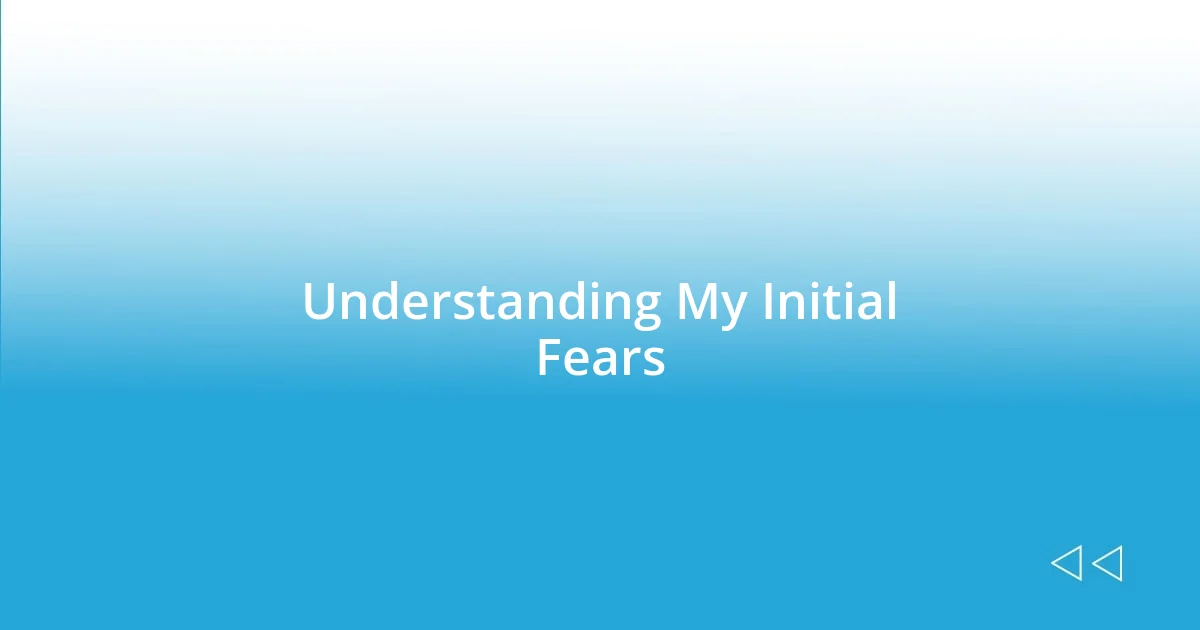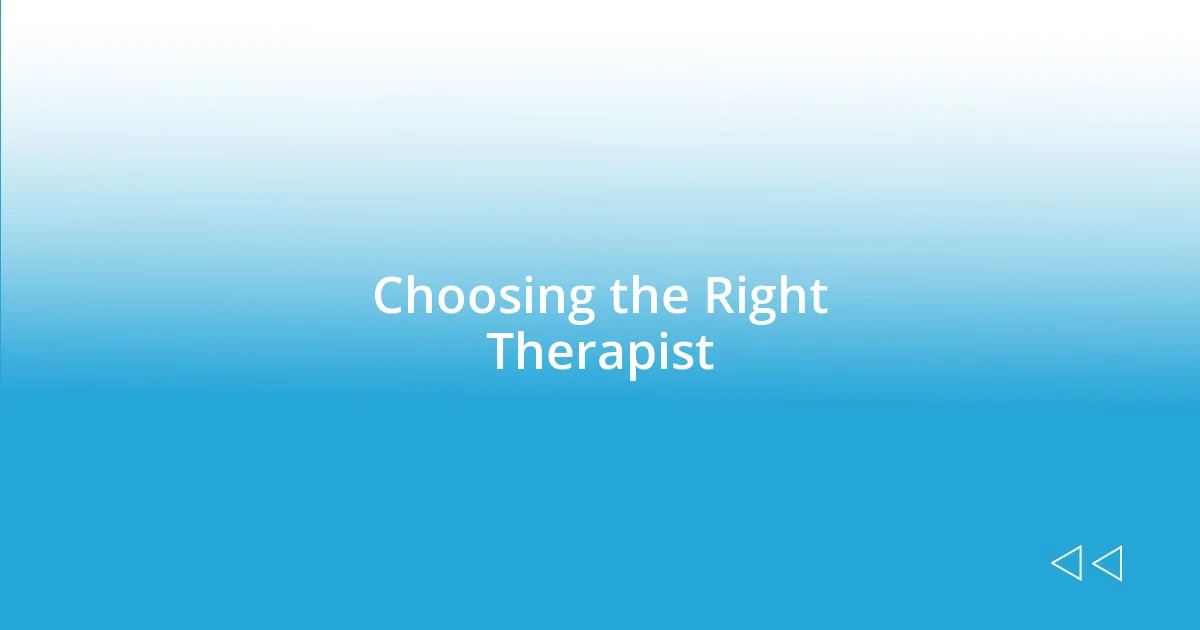Key takeaways:
- Initially fearful of therapy, the author learned that acknowledging feelings and seeking professional help is a courageous step towards healing.
- Finding the right therapist was crucial; a supportive therapeutic relationship fostered trust and allowed for vulnerability.
- Gradual exposure to fears and the use of coping strategies, like mindfulness and journaling, empowered the author to transform challenges into manageable steps, leading to significant personal growth.

Understanding My Initial Fears
When I first stepped into therapy, a rush of fear washed over me. I questioned whether I was actually ready to confront the emotions that had been bottled up for years. Honestly, what if unearthing those feelings only made things worse?
One fear that struck me deeply was the possibility of judgment. I vividly remember sitting in the waiting room, feeling like everyone could see through my facade. Would my therapist see me as “broken” or “weak”? It’s astonishing how our minds can twist perceptions, isn’t it?
Sometimes, I worried about opening up and finding that my experiences were trivial compared to others. Did I truly deserve to be there? That vulnerability felt like standing on the edge of a cliff, uncertain of what awaited me below. It was this whirlwind of fears that made me realize just how important it was to explore them in therapy.

Seeking Professional Help
Seeking professional help was a pivotal step for me. I initially felt overwhelmed by the stigma surrounding therapy. Yet, I quickly learned that it’s a space specifically designed for vulnerability and growth. When I finally made the call to schedule my first appointment, I remember my heart racing—not from fear this time, but from a glimmer of hope. I realized that reaching out for support was, in itself, an act of bravery.
- Acknowledging that I couldn’t handle everything alone was liberating.
- I discovered that therapists are trained to provide a judgment-free zone, which eased my anxieties.
- I found solace in knowing that many people share similar fears, making the therapy journey a common human experience.
- Seeking help allowed me to view my issues through a new lens; no longer something to be ashamed of, but rather a path toward healing.

Choosing the Right Therapist
Choosing the right therapist felt daunting at first, but it became clear that the therapeutic relationship was essential for my healing process. I remember going through a list of potential therapists, focusing not just on their qualifications, but on how I felt when reading their bios. There’s something very personal about trusting someone with your innermost thoughts, and I needed to feel a connection.
During my search, I asked myself important questions: Did their approach resonate with my needs? Could I envision myself being open with them? I learned that compatibility is key; it’s like dating but with the goal of emotional support. My experience taught me that if I felt anxious or overly nervous just thinking about a therapist, it might be a sign that they weren’t the right match for me.
After my first session with a therapist who felt right, I felt a wave of relief wash over me. The first signs of trust were there, and I could see how my fears of judgment began to fade. It’s fascinating to observe how the right therapist can create a safe space that allows you to be vulnerable. Finding that person is worth the effort—it can be like finding a lighthouse during a storm.
| Criteria | Considerations |
|---|---|
| Therapist’s Approach | Is it aligned with your needs? (e.g., cognitive-behavioral, psychodynamic) |
| Experience and Specialization | Do they have experience with your specific issues or demographics? |
| Comfort Level | Do you feel safe and understood in their presence? |
| Availability and Location | Can you easily access their services when needed? |
| Cost and Insurance | Are their fees within your budget, and do they accept your insurance? |

Techniques I Learned in Therapy
One of the first techniques I encountered in therapy was mindfulness, and it genuinely transformed my emotional landscape. I remember sitting in my therapist’s office as they guided me through a simple breathing exercise. It felt strange at first, taking those moments to focus solely on my breath. But as I practiced, I discovered how grounding it was, helping me stay present and reduce anxiety. Have you ever noticed how calming a few deep breaths can be when you’re feeling overwhelmed? That’s the kind of power mindfulness gave me.
Another technique that stood out to me was cognitive restructuring. My therapist encouraged me to challenge negative thoughts as they arose, which sounded daunting at first. For instance, when a wave of self-doubt hit, I started asking myself: “Is this thought factual, or is it just me spiraling?” It felt empowering to take a step back and assess those feelings from a different perspective. I realized that my fears often stemmed from irrational thoughts rather than truth. It’s amazing how simply shifting the language in my mind changed the narrative I told myself.
Finally, exposure therapy became a crucial part of my journey. I vividly recall the first time I confronted a fear that had long held me hostage. My therapist helped me create a gradual exposure hierarchy, starting with small steps and working my way up. When I finally faced that fear, I was amazed at my own resilience. It was like uncovering a hidden strength I never knew existed. Can you imagine how liberating it feels to tackle something that once felt insurmountable? Each small victory built my confidence and made the next challenge seem more manageable.

Facing My Fears Gradually
Gradually facing my fears was a journey, one requiring patience and self-compassion. I remember vividly how my therapist suggested we begin with something small—like simply identifying my fears on paper. Just naming them felt empowering; it was as if I was taking the first step towards demystifying their hold over me. Have you ever noticed how acknowledging a fear can sometimes lessen its grip?
As we progressed, my therapist encouraged me to tackle one fear at a time. I started with something I’d never considered before: speaking up in small social gatherings. The first time I shared my thoughts at a friend’s dinner party, my heart raced, and my palms were sweaty. But I could feel the supportive energy in the room. Each small act of bravery built my confidence and made me realize that the anxiety wasn’t as terrifying as I had once believed. Isn’t it interesting how stepping outside our comfort zones can help us paint a broader picture of who we are?
The more I engaged with my fears, the more I saw them transform from overwhelming giants to manageable challenges. I recall a moment where I had to confront a long-standing fear of public speaking. Instead of launching into a medium-sized audience right away, my therapist suggested practicing in front of a mirror. To my surprise, there was a weird sense of comfort in that simple exercise. It taught me that gradual exposure not only prepares you but also strengthens your resolve. Was it easy? No. But every small step brought significant rewards, and soon, I was ready to tackle bigger audiences with a newfound sense of empowerment.

Building Coping Strategies
Building coping strategies became a crucial part of my therapy journey. One strategy I found incredibly helpful was journaling. I remember starting each session by jotting down my feelings and thoughts, creating a safe space to process what was going on inside my head. Have you ever tried pouring your emotions onto paper? There’s something cathartic about externalizing those swirling thoughts, making them feel less daunting and more manageable. It became my way of organizing chaos and finding clarity.
Another effective strategy was developing a toolkit of calming techniques I could use whenever anxiety struck. One evening, I decided to create a “Calm Box” filled with items that grounded me—like my favorite scented candle, a soft blanket, and some comforting herbal tea. Whenever I felt overwhelmed, I could turn to this box and engage with the items inside. It was like having a personal sanctuary right at my fingertips. In those moments, I would ask myself, “What can I do to help myself right now?” and the answer often lay within that small collection.
Lastly, I embraced the power of positive affirmations. Whenever self-doubt crept in, I would repeat phrases like, “I am capable,” or “I’ve faced challenges before.” I remember standing in front of my mirror one morning, giving myself a pep talk, and it felt almost silly at first. But over time, those affirmations began to reshape the dialogue in my mind. Have you ever realized how your inner voice impacts your day-to-day experiences? I found that these affirmations were more than just words; they became a shield against negativity, empowering me to face whatever lay ahead.

Reflecting on My Progress
Reflecting on my progress has often left me in awe of how far I’ve come. One day, in therapy, I sat in front of my therapist, looking back at the first few sessions where I struggled to even vocalize my fears. I remember feeling overwhelmed, but now, I share those experiences freely, recognizing them as stepping stones. Have you ever stopped to really think about your own journey? It can be enlightening to see the transformation unfold.
I often remind myself of the moments when I wasn’t sure if I could handle my anxiety. In one particular session, I grasped how far I had shifted from avoidance to addressing my fears head-on. I hesitated to come to grips with the reality of my progress, yet there I was, doing things I once thought were impossible. It was a surreal feeling that taught me the importance of becoming my own cheerleader.
As I reflect, I see the interwoven threads of courage and vulnerability in my journey. The thought of sharing my story often made me cringe, but sitting there, I realized each brave moment added to my resilience. It’s those little victories that count, like having a meaningful conversation with a stranger or attending an event I once would have avoided. Doesn’t it fill you with pride to realize how you’ve tackled challenges along the way? For me, acknowledging every step, no matter how small, reinforces that I’m on a path of growth—one that I can continue to navigate with confidence.
















